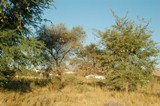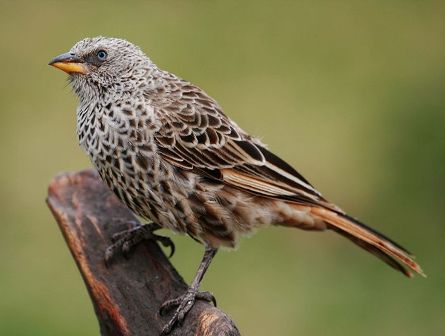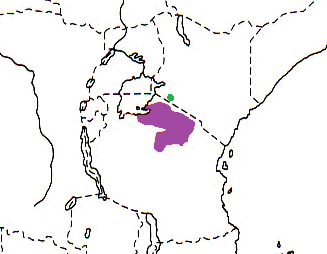Weaver news
|
The Rufous-tailed Weaver Histurgops ruficauda is in the monotypic genus Histurgops. The meaning of Histurgeo is "to weave (i.e. a weaver bird)" and ops means "face" so the genus name means weaver-faced! (or appearance of a weaver). Sexes are similar. This species is grey-brown with a scaly and mottled head and body and rufous tail and wing-patch. The eye colour is unique among weavers in being bluish-white (but brown in juveniles). Photo, right:
The distribution map (below) is based on Birds of Africa, showing its restricted distribution in northern Tanzania (purple). However, on 4 July 2000 Dave Richards recorded a group of 5 birds in the Maasai Mara in Kenya, near the border. More records followed from 2007 onwards and the first breeding record in Kenya was recorded by Colin Jackson, as a colony of 7 nests, with chicks, on 14 April 2010. These records are shown in green. No subspecies have been described for this species. The Rufous-tailed Weaver inhabits savanna thornveld. It forages on the ground, feeding on seeds, insects and fruit. The birds run on the ground, their legs being longer than those of mostly arboreal weavers, and flocks also make short flights low across the ground while feeding. They often associate with starlings or buffalo-weavers. They are tame and confiding around some national parks and lodges, where they may beg for food.
The Rufous-tailed Weaver is monogamous and colonial, with up to 30 nests per tree. They are resident at their nesting colonies and continue building all year. The nest is a ball of grass with a short, wide entrance spout. Initially the nest has two openings with one being closed when eggs are laid, as happens in White-browed Sparrow-weavers. Gall acacias are preferred as nest sites, with nests usually placed 1.5-4 m above the ground. Nests may be used for breeding by Superb Starlings, and for roosting by Fischer's Lovebirds. Although common within its range, incubation and nestling periods are not known for this species. There are two PHOWN records for this species (see summary), the first being submitted by Colin Beale (see news story). Many more records are needed, particularly with nest counts to obtain more information on variation in colony size. Submit any weaver nest records to PHOWN (PHOtos of Weaver Nests) via the Virtual Museum upload site. PHOWN summary Previous Wedn: Bob-tailed Weaver Full weaver species list |













